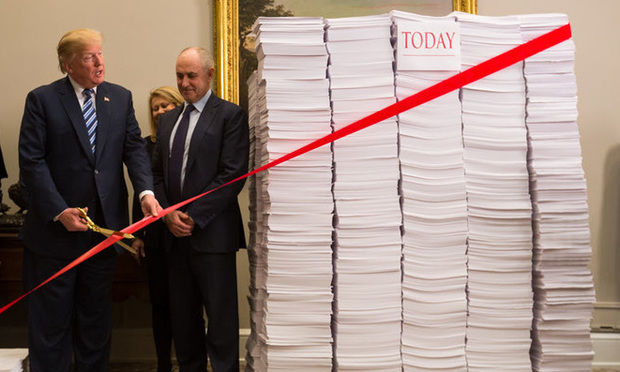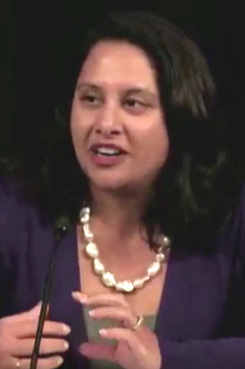 President Donald Trump heralding a new era of deregulatory policy. Credit: White House
President Donald Trump heralding a new era of deregulatory policy. Credit: White House
The Trump administration had a “banner” year for regulatory reform in fiscal 2017, slowing “the production of new, costly regulations,” issuing “only three significant new” ones, and redirecting the “regulatory inertia,” Neomi Rao, President Donald Trump’s regulatory czar, said Friday.
Speaking at the Brookings Institution in Washington, Rao, administrator of the Office of Information and Regulatory Affairs, noted Friday that Trump’s “ambitious” executive orders issued last year calling for agencies to knock out two regulations for every new one and to impose zero regulatory cost in 2017, have worked.
“If you look back on the past year, what we see is that those orders focused attention on a very big problem of cumulative regulations,” said Rao, former professor at the Antonin Scalia Law School at George Mason University, who was nominated to head OIRA by Trump last April.
“The administration didn’t go after the problem with little scissors, but really with something more like the big, beautiful gold scissors … to cut red tape,” Rao said.
“The president directed the agencies to deregulate, and that’s what they’ve been doing,” she said.
“We withdrew or delayed more than 1,500 planned rules. Now those are rules that are currently in process and rules that we’re thinking about, but it demonstrates the magnitude of what’s been halted or postponed.”
 Neomi Rao
Neomi Rao
The administration “is carefully reconsidering the direction, scope and the content of many proposed regulations.”
Rao added that OIRA’s goal has been to “incentivize agencies” to eliminate and streamline burdens “of all sizes,” while maintaining the “very high standards of regulatory analysis that we expect from agencies.”
OIRA has slowed the pace of “new, significant” rules but also of “small” ones and “eliminated costly regulatory” actions—including rules, as well as guidance documents and information collections.
Across the government, she continued, “we’ve eliminated 22 regulatory actions for every one new regulation—a ratio that far exceeds the two for one that the president called for.”
The paring of regulations has produced a savings of more than $8 billion in regulatory costs, the “first time in our records” that the total hasn’t grown, Rao said.
Regulatory costs, Rao asserted, have historically increased in previous administrations regardless of which party controlled the White House.
Looking Ahead
For fiscal 2018, agencies “have committed to reducing regulatory costs even further, by more than $10 billion,” she said.
In the second year of reg reform, OIRA also wants “to work closely with agencies to identify some very serious and substantial areas for reform.”
Citing OIRA’s fall unified agenda, agencies “are proposing some 448 deregulatory actions and 131 regulatory actions,” she said—“a better than 3 for 1 ratio.”
However, she added, “significant deregulation takes time. Reconsidering big rules requires new research, new analysis and of course the full rulemaking process with notice and comment.”
‘Solving an Actual Problem’
In 2018, OIRA will continue to implement the Trump administration’s goal of “systematically trying to crack down on bad regulatory practices, and make sure that agencies are proceeding in a manner that is consistent with law,” Rao said.
“Even when an agency has legal authority to proceed, we want to make sure that they are working to solve an actual problem. We want to make sure there’s some reason for the government to act, such as a substantial market failure.”
In that regard, she continued, OIRA is “pushing hard to demand a very fair analysis of both the costs and benefits of regulation,” she said.
“Too often in the previous administration, the benefits were exaggerated and the costs downplayed. We would like to have as fair an accounting of both of those as possible.”
Added Rao: “While retrospective review [of rules] has been around for a long time, we’re giving some real teeth to that.”
Another OIRA goal in the new year is to “change the culture so that when an agency issues guidance, it’s truly a guidance about existing requirements and not a back door to imposing new regulatory requirements,” Rao said.
Read more:
John Ring of Morgan Lewis, Trump Pick for NLRB, Discloses $2.7M Partner Share
Trump Considers Senate Commerce Lawyer for Consumer Product Commission
Seyfarth, Luring Top Labor Lobbyist, Moves to Boost Influence Services
Mick Mulvaney Says CFPB Won’t ‘Push the Envelope’ Any Longer
Originally published by ThinkAdvisor. All rights reserved. This material may not be published, broadcast, rewritten, or redistributed.


